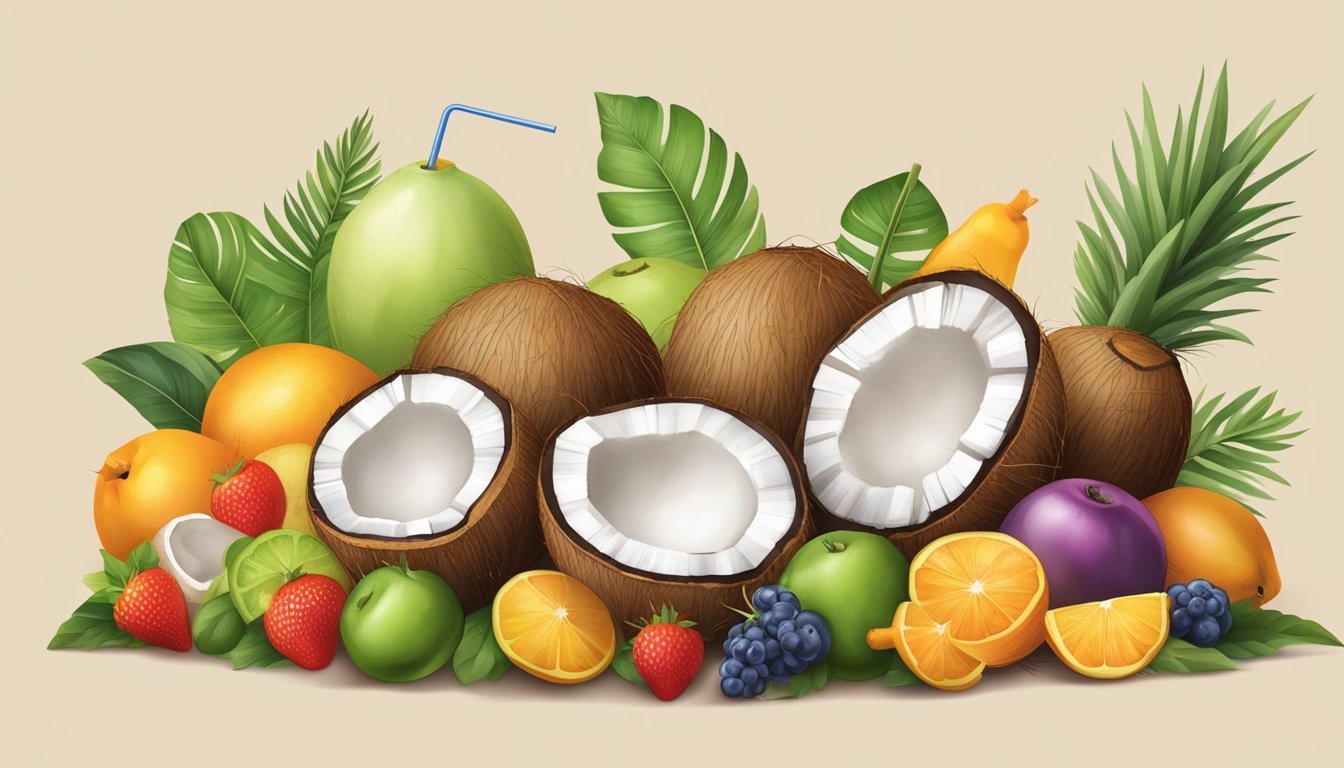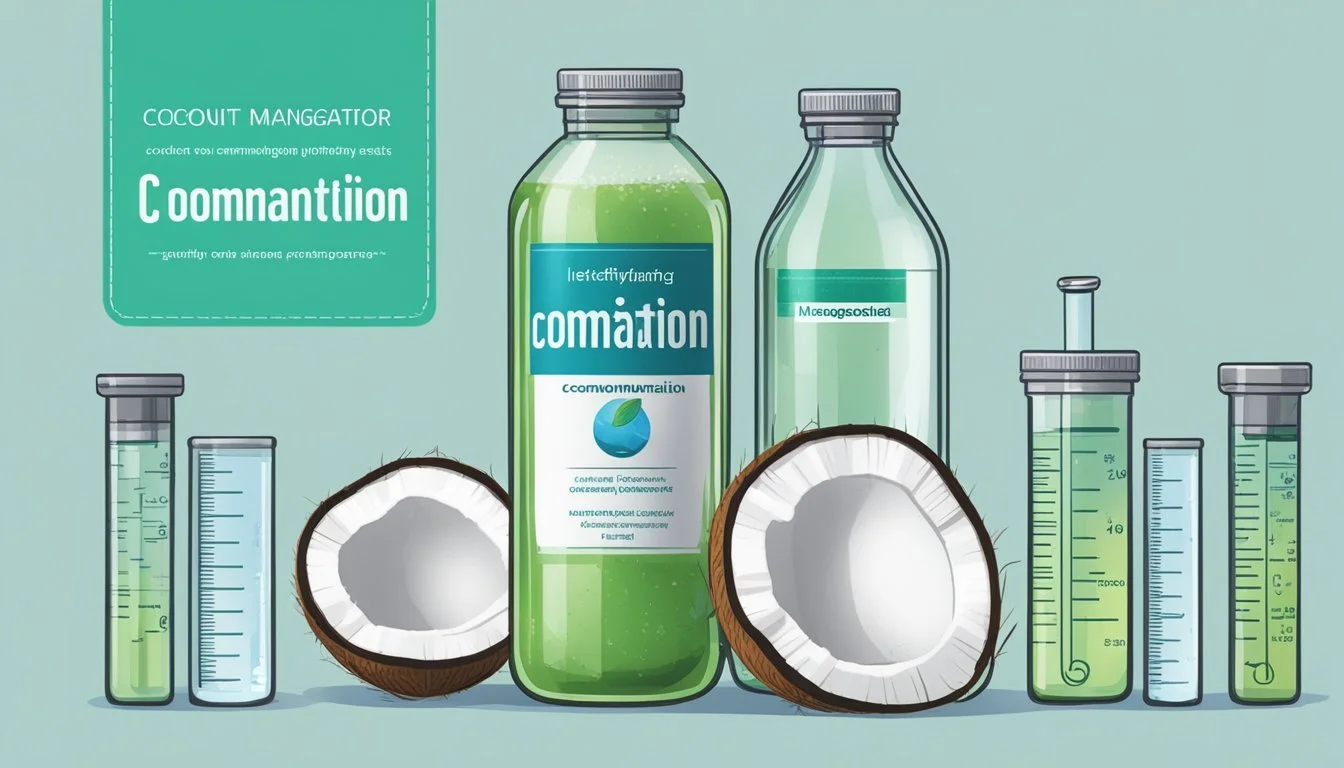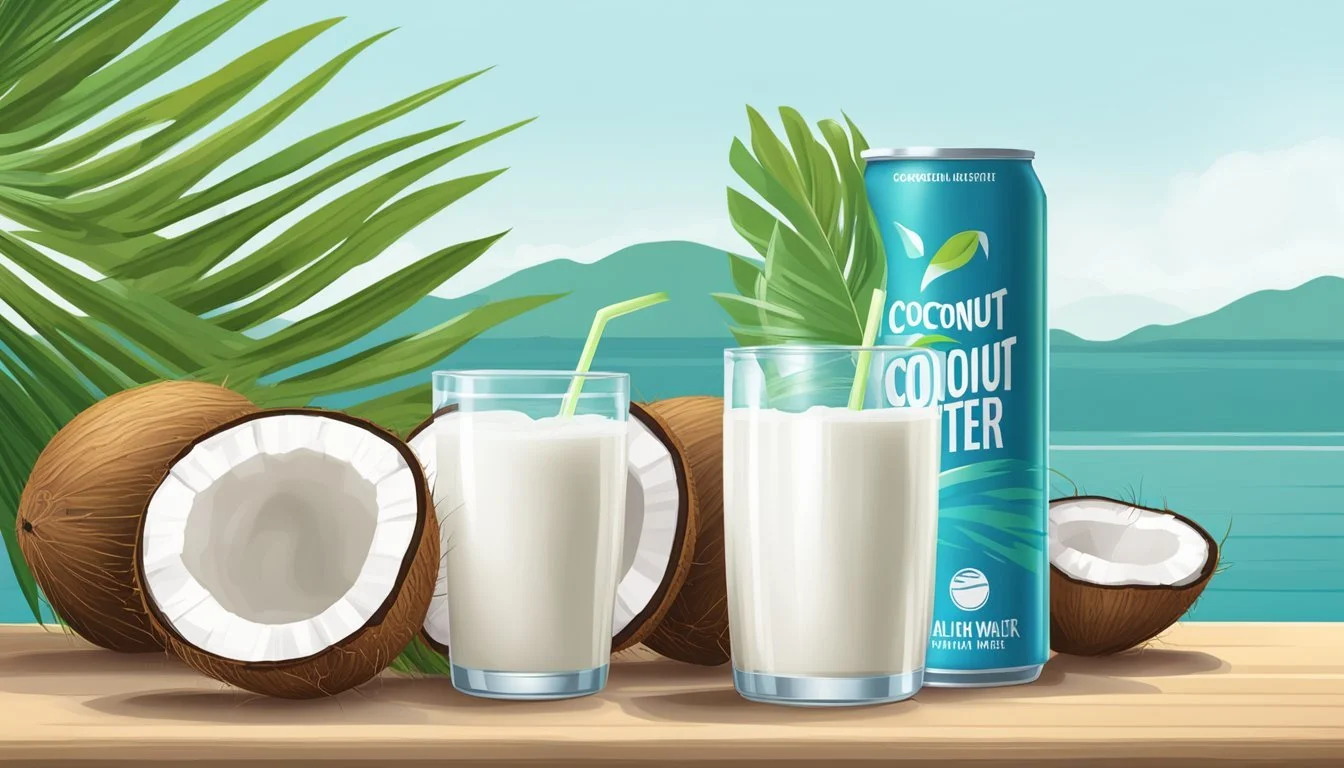Does Coconut Water Go Bad?
Shelf Life and Storage Tips
Coconut water, renowned for its hydrating properties and health benefits, is a popular choice among those seeking a natural alternative to sports drinks. Yes, coconut water can go bad, particularly when not stored properly.
Maintaining the freshness of coconut water requires attention to storage conditions. Unopened containers should be kept in a cool, dry place, away from heat and sunlight. Once opened, refrigeration is key; the water should be consumed within 24 to 48 hours to ensure its quality and safety.
Physical signs of spoilage include a sour smell, changes in taste, or an altered, slimy texture. If any of these signs are present, it's best to discard the coconut water to avoid potential health risks. Proper storage can significantly extend its shelf life, making it a reliable source of hydration and nutrients.
Nutritional Profile of Coconut Water
Coconut water is a rich source of essential nutrients and minerals. It is low in calories and contains antioxidants. Its electrolyte content makes it an excellent choice for hydration.
Vital Nutrients and Minerals
Coconut water is an excellent source of potassium. One cup of ready-to-drink, unsweetened coconut water offers around 404 milligrams of potassium. This mineral is vital for maintaining proper heart and muscle function.
Besides potassium, coconut water provides magnesium, sodium, and calcium. These minerals are essential for various bodily functions like bone health, muscle contractions, and nerve function.
The water also contains small amounts of other nutrients like vitamin C, which support immune health and skin vitality.
Calories and Antioxidants
Coconut water is low in calories, with one cup containing approximately 44 calories. It is free from fats, making it a good option for those looking to manage their calorie intake.
Antioxidants present in coconut water help combat oxidative stress and inflammation. These include compounds like vitamin C and plant hormones such as cytokinins. These antioxidants contribute to overall health by neutralizing harmful free radicals.
Electrolyte Content for Hydration
Coconut water's electrolyte content is a significant factor in its hydrating properties. The drink contains essential electrolytes like potassium, sodium, and magnesium.
These electrolytes help maintain fluid balance, prevent dehydration, and sustain energy levels. After intense physical activities or in hot climates, coconut water can effectively replenish lost electrolytes.
The natural balance of these nutrients makes it a preferred choice for hydration compared to other sugary sports drinks.
Understanding Shelf Life
Coconut water, although refreshing and nutritious, has a limited shelf life. Key factors include whether the container is opened or unopened and the visible signs of spoilage.
Expiration Date Significance
The expiration date on coconut water packaging is a guideline for peak quality, not an absolute indicator of safety. Unopened coconut water can often remain drinkable well beyond this date if stored properly, sometimes lasting up to a year past the marked date. The best-by date reflects optimal taste and nutrient content rather than safety. Storage conditions play a crucial role, with a cool, dark place being ideal for longevity.
Opened vs Unopened Coconut Water
Unopened coconut water should be stored in a cool, dry place and can last up to a year. Once opened, the protective seal is broken, and exposure to air accelerates spoilage. Opened coconut water should be refrigerated and consumed within 2-3 days. Extending this period risks degradation in taste and safety. Refrigeration slows spoilage but does not stop it completely.
Signs of Spoilage
Identifying spoilage in coconut water is essential for safety. Spoiled coconut water can exhibit several physical signs:
Sour smell: Fresh coconut water has a mildly sweet, nutty aroma. A sour or off-putting smell indicates spoilage.
Color change: While fresh coconut water is clear to slightly opaque, a pink or brown hue suggests fermentation.
Texture: If carbonation or abnormal thickness is present, the water is likely spoiled.
Mold: Visible mold is an obvious sign to discard the product immediately.
These indicators ensure the consumer avoids consuming spoiled coconut water, maintaining safety and enjoyment.
Proper Storage Practices
Proper storage of coconut water can significantly extend its shelf life and ensure safety for consumption. Key factors include choosing between refrigeration and pantry storage and protecting it from heat and sunlight.
Refrigeration vs Pantry
Unopened coconut water can be stored at room temperature, such as in a pantry, for up to one year if kept in a cool, dry place away from direct sunlight. Once opened, it must be refrigerated to prevent spoilage and should be consumed within 24 to 48 hours.
Refrigeration slows down the growth of bacteria and preserves the freshness of the coconut water. For longer storage, sealed containers are crucial to maintain quality. If any sour smell or flavor develops, discard the coconut water immediately.
Impact of Heat and Sunlight
Exposure to heat and sunlight can deteriorate the quality of coconut water quickly. High temperatures accelerate bacterial growth, leading to spoilage. Store unopened coconut water in cool, dark places to avoid this risk.
Direct sunlight can alter the taste and nutritional content of the water. Using opaque containers or keeping them in shaded areas is advisable to protect against UV rays. Whether stored in the pantry or refrigerator, maintaining a consistent temperature helps in preserving its natural flavor and nutritional value.
By adhering to these practices—keeping coconut water cool and away from sunlight—consumers can enjoy its refreshing taste and health benefits for a longer period.
Assessing Coconut Water Quality
Ensuring the quality of coconut water involves evaluating its appearance, smell, taste, and texture. Recognizing the signs of spoilage can help maintain freshness and avoid consuming degraded coconut water.
Appearance and Color
Coconut water should be clear or slightly cloudy with a consistent color. A significant change in color, such as turning dark, might indicate spoilage.
Sometimes, sediment can appear, which is natural, but it should not be excessive.
If mold or any floating particles are present, the coconut water is no longer safe to drink.
Visual inspection is essential for confirming its freshness and quality.
Smell and Taste
Fresh coconut water typically has a sweet, nutty aroma. If it emits a sour or off-putting smell, it is an indication of spoilage.
The taste is another critical factor. Fresh coconut water should have a sweet taste. However, a sour or fermented flavor suggests it has gone bad.
Regularly tasting and smelling coconut water before consumption helps ensure it is still good.
Texture and Consistency
The texture of coconut water should be thin and watery.
A thick or slimy consistency is a strong sign that it has spoiled and should not be consumed.
When the texture deviates from its usual smooth nature, it indicates bacterial growth or other types of degradation.
Checking the texture effectively prevents drinking compromised coconut water.
Guidelines for Consumption
Consuming coconut water safely involves awareness of its shelf life and recognizing signs of spoilage. Expired coconut water poses health risks due to the potential growth of harmful bacteria.
When Is It Safe to Consume
Unopened and stored properly at room temperature, coconut water can last up to a year. Once opened, it should be refrigerated and consumed within 24 to 48 hours.
Signs that coconut water is still good for consumption include:
A pleasant, fresh smell
Clear or slightly cloudy appearance without any discoloration
Normal, natural taste without bitterness or sourness
Proper storage away from heat and sunlight helps extend its shelf life. Always check for any signs of deterioration before drinking.
Health Risks of Expired Coconut Water
Drinking expired coconut water can lead to various health issues. Harmful bacteria and microorganisms thrive in open containers, especially if not refrigerated.
Health risks include:
Foodborne illnesses, such as gastroenteritis
Symptoms like nausea, vomiting, and diarrhea
Potential ingestion of mold and spoilage bacteria
If coconut water smells sour, tastes off, or has changed in texture, it should be discarded. Even slight changes can indicate the presence of contaminants, posing a risk to health.
Preservation Techniques
Preservation of coconut water involves the use of preservatives and freezing techniques to extend its shelf life. These methods help maintain its freshness and nutritional value, making it suitable for longer storage.
The Role of Preservatives
Preservatives and additives play a critical role in extending the shelf life of packaged coconut water. Common preservatives, like ascorbic acid (vitamin C) and citric acid, are used to prevent spoilage.
They help maintain the drink's color and flavor while inhibiting the growth of bacteria and mold.
Tetra Pak containers often house coconut water because they provide an oxygen barrier, reducing oxidation and spoilage. Consumers should check labels for preservatives and additives, as preferences for natural or synthetic options vary.
Proper storage at recommended temperatures further ensures the effectiveness of these preservatives.
Freezing Coconut Water
Freezing is another effective method to preserve coconut water. Consumers can pour the beverage into ice cube trays for easy portioning and later use. Once frozen, transfer the cubes to airtight containers or Ziploc bags to prevent freezer burn and contamination.
Defrosting should be done in the refrigerator. This method maintains the quality of the coconut water better than rapid thawing with warm water.
Properly frozen and stored coconut water can last for several months, but it is best used within a few weeks for optimal taste. Avoid refreezing thawed coconut water as this can degrade its quality.
Implementing these techniques successfully prolongs the life of coconut water while preserving its refreshingly sweet flavor and nutritional benefits.
Pasteurization and Coconut Water Quality
Pasteurization plays a crucial role in extending the shelf life and maintaining the quality of coconut water while presenting distinct differences from unpasteurized options.
Benefits of Pasteurization
Pasteurization's main benefit is its ability to inactivate harmful microorganisms and enzymes. This is achieved by heating the coconut water to a specific temperature, commonly around 161 degrees Fahrenheit for 15 seconds, before rapidly cooling it.
This process helps in prolonging the shelf life of coconut water, making it safer for longer periods. Brands like Harmless Harvest use pasteurization to ensure their products remain fresh for up to a year when refrigerated.
Additionally, pasteurized coconut water retains most of its nutritional value, such as vitamins and minerals, while ensuring a uniform taste and quality across batches.
Differences in Unpasteurized Options
Unpasteurized coconut water, on the other hand, is not subjected to heat treatment and maintains a closer profile to fresh coconut water. This option is favored by some for its more natural taste and minimal processing.
However, it has a significantly shorter shelf life, typically lasting only a few days after opening when refrigerated. The risk of bacterial contamination is higher, and spoilage can occur quickly.
For those seeking a fresh, raw experience, unpasteurized varieties provide the benefit of tasting closer to freshly extracted coconut water, though consumers should be mindful of the shorter storage time and higher spoilage risk.
Innovative Uses for Coconut Water
Coconut water can be enjoyed in various forms and has found its way into many culinary and beverage practices. It not only adds a unique flavor but also boosts the nutritional profile of dishes and drinks.
Coconut Water in Culinary Creations
Coconut water is increasingly being used in cooking to create exotic dishes. Marinades benefit from its slightly sweet and nutty flavor, making meats and vegetables more tender and flavorful. When used in soups and stews, coconut water adds depth and a tropical twist. For dessert lovers, gelatin desserts and puddings can be made more interesting by substituting coconut water for regular water, resulting in a unique and delicious taste.
In baking, replacing regular water with coconut water in bread and cake recipes results in a moist and aromatic product. For rice and grains, cooking them in coconut water instead of plain water infuses them with a subtle, sweet flavor that pairs well with many types of cuisine. Additionally, salad dressings mixed with coconut water offer a refreshing and light alternative to traditional dressings.
Coconut Water as a Beverage Addition
Coconut water enhances beverages in a variety of delightful ways. Smoothies, for instance, benefit greatly from its addition. Replacing regular liquids with coconut water not only enhances flavor but also increases hydration and nutritional content. On a hot day, homemade popsicles made with coconut water are both refreshing and healthful.
Cocktails such as piña coladas and mojitos can be elevated by incorporating coconut water, providing a lighter and more nutritious option. Blending it with other fruit juices creates a delicious and revitalizing drink. Whether mixed with water, used in energy drinks, or simply enjoyed on its own, coconut water's versatility makes it an excellent addition to various beverages.
Identifying and Managing Contamination
Ensuring the safety and quality of coconut water involves recognizing signs of contamination and taking measures to prevent it. Key areas to focus on are the visible signs of mold and bacterial growth and strategies for preventing contamination and deterioration.
Visible Mold and Bacterial Growth
Mold and bacteria can spoil coconut water. Common signs include a change in color, odor, and texture. A sour or rancid smell often indicates bacterial growth. The presence of mold is typically seen as small, fuzzy patches that range in color from white to green.
Consumers should understand that fresh coconut water should be clear and have a slightly sweet, nutty aroma. If the water appears cloudy or has an unusual taste, it’s best to dispose of it to avoid potential health risks.
Observing these signs can help people avoid consuming contaminated coconut water, which may lead to gastrointestinal issues and other health problems.
Preventing Contamination and Deterioration
Proper storage is crucial to maintaining the quality of coconut water. Once opened, coconut water should be refrigerated and consumed within 24 to 48 hours. This helps limit bacterial growth and preserves freshness.
Using sealed, clean containers can prevent exposure to air and contaminants. Avoid keeping coconut water at room temperature for prolonged periods, as this encourages microbial growth.
When purchasing packaged coconut water, check the expiration date and ensure the packaging is intact. Avoid cans or bottles that appear damaged or bulging, as these could indicate spoilage.
By following these guidelines, consumers can enjoy the health benefits of coconut water while minimizing the risk of contamination and deterioration.
Responding to Environmental Factors
Environmental factors like temperature and exposure to elements can significantly impact the shelf life and quality of coconut water. Proper storage and handling are crucial to maintaining its freshness.
Effects of Extreme Temperatures
Extreme temperatures, both high and low, can affect coconut water. When exposed to heat, the water can spoil faster. High temperatures can break down the natural sugars and nutrients, leading to an off flavor and smell. Therefore, keeping coconut water away from direct sunlight and storing it in a cool, dry place is essential.
On the other hand, freezing coconut water might alter its taste and texture. If frozen, the water expands, potentially breaking the packaging and exposing the contents to bacteria. Always ensure that coconut water is stored within recommended temperature guidelines to retain its quality.
Protecting Coconut Water from the Elements
Protecting coconut water from environmental elements such as light, air, and moisture is crucial. Sunlight can degrade the nutrients and cause the liquid to spoil faster. Heat and light together can accelerate the growth of microorganisms, leading to spoilage.
Store unopened coconut water in a cool, shaded area, away from heat sources. Once opened, it’s vital to refrigerate it and consume it within 24 to 48 hours. Air exposure can also affect its quality, so always ensure the container is tightly sealed after opening.
Using the appropriate storage methods will help extend the shelf life of coconut water, keeping it fresh and safe to consume. Following these guidelines can significantly reduce the risk of spoilage from environmental factors.
Differentiating Coconut Water from Coconut Milk
Coconut water and coconut milk are distinct in their origins, compositions, and uses. Knowing the differences will help you choose the right one for your needs.
Characteristics of Coconut Water
Coconut water is a clear, naturally fat-free liquid found inside young, green coconuts. Typically, each coconut contains about 200-300 ml of this refreshing liquid. It is known for its hydrating properties and is a popular beverage for replenishing electrolytes, especially potassium, after physical activity.
Fresh coconut water is consumed directly from the coconut or is available in packaged forms like bottled or canned coconut water. It has a slightly sweet taste due to natural sugars and is low in calories compared to coconut milk.
Nutritional Profile:
Calories: Low
Fat: 0g
Carbohydrates: Primarily from natural sugars
Electrolytes: High in potassium
This composition makes coconut water an excellent hydrating drink, suitable for athletes and individuals seeking a low-calorie beverage.
Characteristics of Coconut Milk
Coconut milk is derived from the grated pulp of mature coconuts. It has a rich, creamy texture due to its high-fat content, which comes from the coconut flesh. This milk is often used in cooking, especially in Southeast Asian and Caribbean cuisines, adding a distinct flavor and creamy texture to dishes.
Coconut milk can be found in different forms, including thick canned coconut milk and lighter, beverage-style coconut milk. Unsweetened varieties provide a low-carbohydrate alternative suitable for ketogenic and other low-carb diets.
Nutritional Profile:
Calories: Higher
Fat: Significant (includes saturated fats)
Carbohydrates: Low in unsweetened varieties
Nutrients: Contains calcium and other essential nutrients
Coconut milk's higher fat content offers a richer flavor and is ideal for culinary uses, ranging from curries to desserts.












